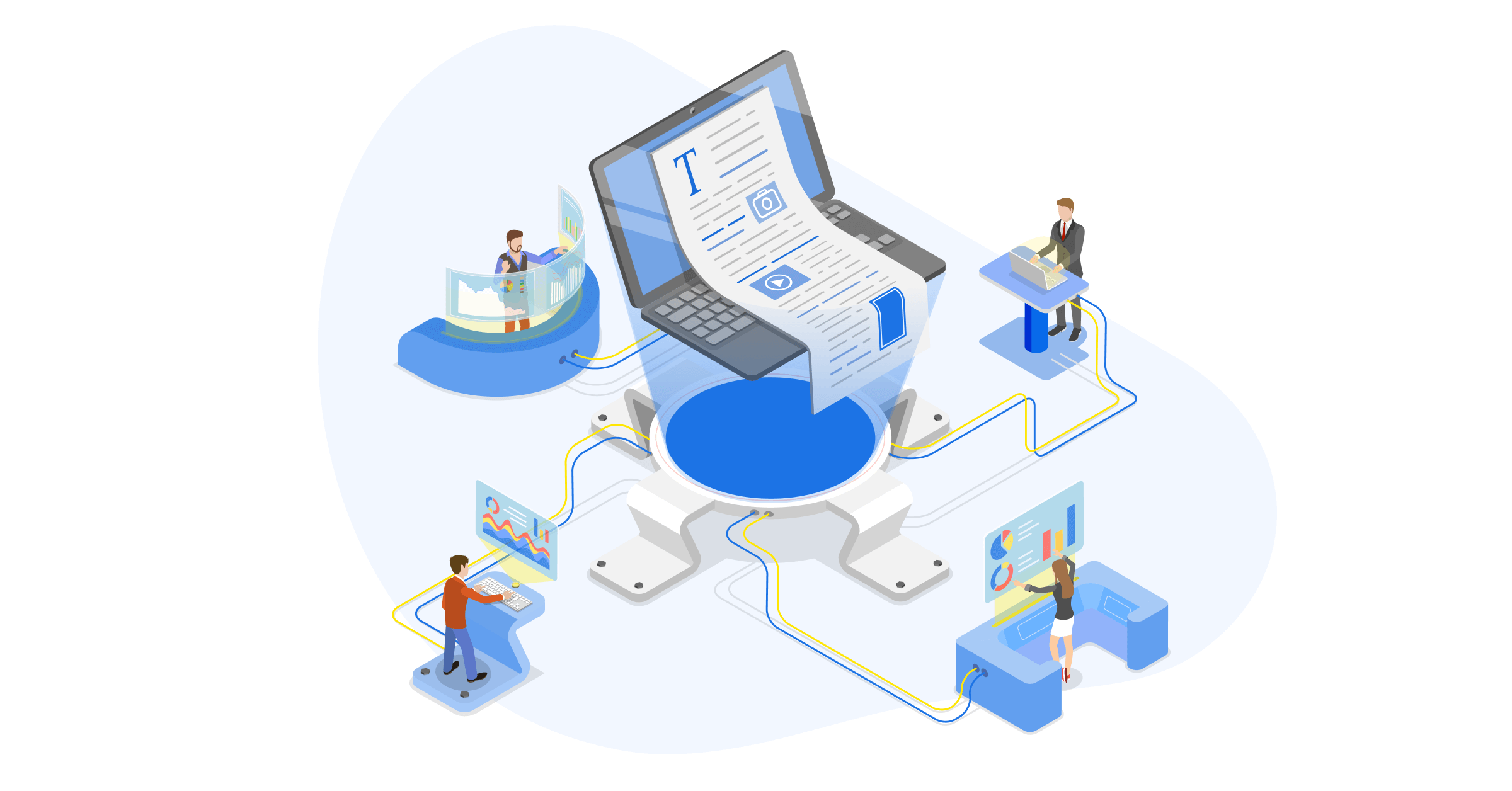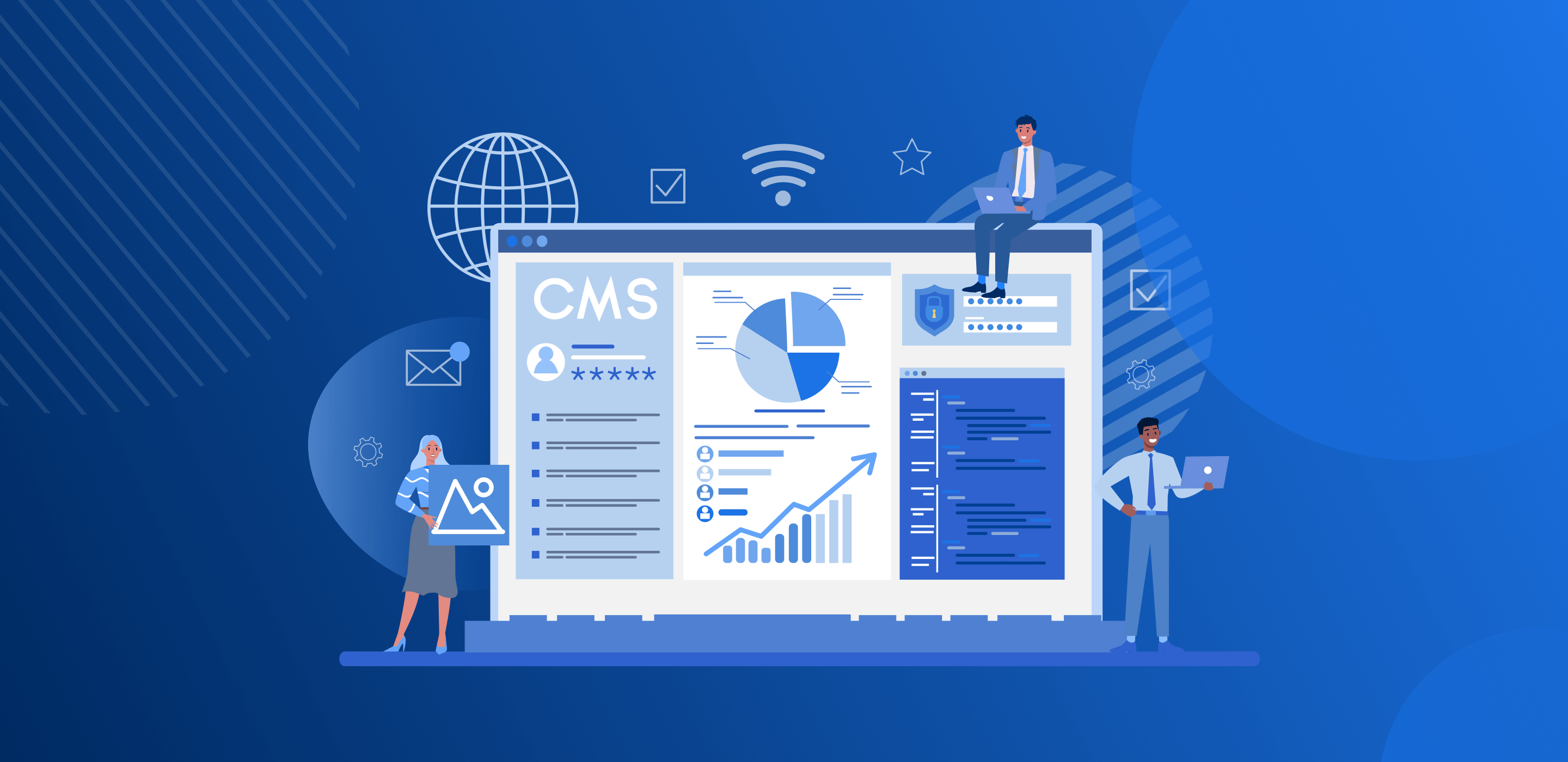Feel like you’re overwhelmed by an immense amount of data, desperately seeking air as successive deluges of digital material bombard you? If so, enterprise cms might be the life raft you need.
I remember the days when managing our company’s vast content felt like trying to herd cats – impossible and utterly frustrating. But then we discovered enterprise CMS platforms.
Their ability to streamline workflows, protect customer data, and enhance user collaboration was transformative. Suddenly, instead of being overwhelmed by torrents of information, we were sailing smoothly on calm seas.
Intrigued? Stick around as I dive deeper into these game-changing systems – their key features, top platforms like Adobe Experience Manager and Sitecore Experience Manager – and how they can revolutionize your business efficiency. Trust me; this is one journey worth taking!
Table Of Contents:
- Understanding the Enterprise CMS Landscape
- Key Features to Look for in an Enterprise CMS
- The Impact of Enterprise CMS on Business Efficiency
- Evaluating the Top Enterprise CMS Platforms
- Leveraging Enterprise CMS for Enhanced Customer Experiences
- Harnessing the Power of Reporting and Analytics in Enterprise CMS
- FAQs about Enterprise CMS
- Conclusion
Understanding the Enterprise CMS Landscape
An enterprise CMS is more than just a way to produce and circulate content; It’s an essential part of managing digital experiences in large organizations. Let’s consider this: workers spend as much as 20% of each day looking for lost or misfiled documents, according to McKinsey. That’s where an effective enterprise CMS comes into play.
Defining Enterprise CMS
A robust enterprise CMS platform is a hub that helps you manage web content efficiently across multiple channels while ensuring regular updates. A key feature includes user access control, enabling different levels of permissions among your team members based on their roles within your organization.
Beyond basic features like asset management and editing tools for non-technical users to easily create personalized experiences, these platforms also have advanced capabilities such as integration with IoT devices and AI-powered automation to help deliver engaging customer experiences.
The Role of Enterprise CMS in Large Organizations
In today’s digital age, large enterprises need a flexible CMS solution capable of handling large volumes of data without compromising security. This is where the learning curve plays a vital role – the easier it is for teams to adopt new technologies, the quicker they can leverage its benefits.

Moreover, having seamless collaboration amongst team members who are spread out geographically has become crucial, too. With over 63 million websites using some form of CMS, choosing one that caters to enterprise business needs becomes imperative.
Spotlight on Popular Platforms
Adobe Experience Manager and Sitecore Experience Manager are leading enterprise CMS platforms. Adobe Experience is known for its flexible architecture, allowing you to create custom workflows that match your business processes.
On the other hand, Sitecore offers a hybrid solution – combining the traditional CMS with headless capabilities, enabling developers and content creators alike to publish content more efficiently. This flexibility often results in a lower total cost of ownership over time.
Enterprise CMS is a game-changer, making content management efficient and helping teams deliver engaging digital experiences. It’s not just about publishing; it includes advanced features like AI automation and IoT integration. Top platforms? Adobe Experience Manager for custom workflows, Sitecore for hybrid solutions.
Key Features to Look for in an Enterprise CMS
An enterprise Content Management System (CMS) can be a powerful asset, yet its worth depends on the features it provides. Let’s examine what makes an effective enterprise CMS.
User-Friendly Content Creation Tools
The best enterprise teams often comprise people with diverse skill sets. Not everyone will be tech-savvy; some might even dread creating digital content.

A user-friendly platform can be a real asset, allowing those who may not have technical expertise to contribute and create content with ease. A great CMS should let non-technical users create and edit content easily, fostering more collaboration across your team. This helps you manage content efficiently and ensures everyone can contribute ideas.
Multi-Channel Publishing Capabilities
In today’s interconnected landscape, customers exist across multiple channels and platforms – from social media to mobile apps and websites to IoT devices.
A capable enterprise CMS needs multi-channel publishing capabilities so that you can reach out wherever your customers may be. The right system should allow for seamless integration with various platforms like HubSpot’s CMS hub, enabling you to deliver engaging experiences no matter how wide-ranging your customer base may be.
Beyond these key features, several other factors set superior systems apart:
- Flexible architecture: An excellent CMS provides an elastic structure that allows businesses of all sizes – large enterprises or startups – to scale their operations and content management effectively.
- Customer data protection: With rising concerns over data security, a good CMS should have robust measures to protect customer information from breaches.
- User access control: The ability to define who can do what is critical. A system that lets you manage user access ensures that only authorized personnel make changes where necessary.
Scale. An enterprise CMS equips your team with the right tools to create content efficiently. It is a vital asset for businesses looking to manage and publish their digital content effectively.
User-Friendly and Multichannel: A top-notch enterprise CMS should give your diverse team easy-to-use content creation tools, fostering collaboration. It needs multi-channel publishing capabilities to reach customers wherever they are – social media, mobile apps, or IoT devices. Flexible and Secure: It’s essential to choose a CMS that boasts both flexible architecture and top-notch security. This combo lets you easily tailor your site, all while keeping data safe.
The Impact of Enterprise CMS on Business Efficiency
Every successful business knows that efficiency is key to growth. An enterprise Content Management System (CMS) is pivotal in streamlining workflows, safeguarding customer data, and integrating marketing automation tools for personalized experiences.
Streamlining Workflows and Collaboration
An efficient enterprise CMS can be the grease that keeps your company’s wheels turning smoothly. It lets teams work together seamlessly by managing content effectively across multiple channels – from web content to mobile apps. The beauty lies in its ability to let you publish once and distribute everywhere.
A study from BuiltWith found an interesting fact: 63 million websites use a CMS, which emphasizes how these platforms make collaboration more straightforward.
This streamlined process improves team cohesion and significantly reduces the time spent searching for lost or misfiled documents. Workers spend as much as 20% of each day looking for misplaced files – think about what they could achieve with all this extra time.
Enhancing Security Measures
In today’s digital world, security has become paramount. A well-designed enterprise CMS helps protect valuable customer data while maintaining high accessibility standards for authorized users. This means sensitive information stays safe without hindering productivity.

Statistics show, given the sheer volume of data contained within most systems, security features aren’t just important—they’re critical—for large enterprises like yours that need total control over user access.
While open-source CMS platforms may seem tempting due to their lower total cost, they often lack the rigorous security measures required by large organizations. The peace of mind that comes with knowing your customer data is safe and secure? That’s priceless.
Leveraging Marketing Automation
A strong enterprise CMS is more than just a content manager. It’s an essential tool for creating personalized digital experiences.
Campaigns, an enterprise CMS, can push your business to the next level. It not only secures your customer data but also keeps it easily accessible. With a good CMS, you’re set for increased productivity and improved security while delivering personalized experiences that resonate with your customers.
Evaluating the Top Enterprise CMS Platforms
Enterprise businesses need a robust and flexible CMS solution when managing digital content. Among the myriad options available in today’s market, two platforms have become prominent: Adobe Experience Manager and Sitecore Experience Manager.
Adobe Experience Manager, often dubbed as an ‘experience manager,’ is renowned for its capabilities that extend beyond traditional web content management. Its key features include personalized experience creation across multiple channels – from websites to mobile apps, IoT devices, and in-store displays.
The built-in tools enable non-technical users, or ‘content creators’ as they are usually referred to, to easily create custom digital experiences without having any coding skills. It’s not just about ease of use; with Adobe’s asset management system, you can efficiently handle large volumes of assets while ensuring high-security standards.
On the other hand, Sitecore Experience Platform prides itself on being more than a simple website builder—it’s a hybrid solution offering both traditional CMS functionalities alongside advanced marketing features such as customer data tracking for enhanced personalization.
A significant advantage is its scalable architecture, which makes it an ideal choice for large enterprises looking at handling huge amounts of content. The platform allows multiple users simultaneous access with various editing tools designed explicitly, keeping non-technical staff in mind—making content creation a breeze.
Cost Comparison: Total Cost Ownership
An essential factor when evaluating enterprise CMS platforms is total cost ownership (TCO). Although neither Adobe nor Sitecore publicly discloses their pricing models because they provide custom quotes based on individual business needs – we know from firsthand experience that these systems aren’t cheap.
However, the total cost extends beyond just licensing fees. Below is a list of essential factors to evaluate when comparing the Total Cost of Ownership (TCO).
- License Costs:
- Upfront licensing costs for both CMS platforms.
- Additional costs for extra modules or features.
- Implementation Costs:
- Initial setup, configuration, and customization costs.
- Integration Costs:
- Expenses for integrating with other systems, databases, or third-party tools.
- Training Costs:
- Staff training expenses.
- Maintenance and Support Costs:
- Ongoing maintenance, updating, and support costs.
- Vendor or third-party support agreements costs.
- Upgrade Costs:
- Expenses for upgrading to newer versions or adding additional features.
- Hosting Costs:
- Hosting expenses either on-premises or in the cloud.
- Operational Costs:
- Day-to-day operational costs like content creation, management, and moderation.
- Migration Costs:
- Data migration, content reformatting, and redirect configurations costs if migrating from another
- CMS.
- Compliance and Security Costs:
- Expenses to ensure regulatory compliance and security standards.
- Scalability Costs:
- Costs to scale the CMS for organizational growth or traffic fluctuations.
- Performance Monitoring and Optimization Costs:
- Expenses to ensure optimal performance and address any performance issues.
- User Adoption and Change Management Costs:
- Costs related to managing change and ensuring user adoption.
- Custom Development Costs:
- Expenses for custom development to meet specific needs or add functionalities not provided out-of-the-box.
Flexibility: Adobe Experience Manager vs Sitecore
But remember, Adobe isn’t the only one packing a punch in flexibility. There’s another player on the field that also offers plenty of room for customization and personalized experiences to align with your brand.
When picking an enterprise CMS, consider robust options like Adobe Experience Manager and Sitecore. They offer tools for easy content creation but also pack features for personalization and large-scale asset management. Don’t forget to factor in total cost ownership (TCO) beyond licensing fees.
Leveraging Enterprise CMS for Enhanced Customer Experiences
Enterprise Content Management Systems (CMS) play a crucial role in shaping the digital journey of customers. By efficiently managing websites and digital assets, these platforms provide a seamless experience paramount to customer satisfaction.
Centralized Content Management
A single content management system allows companies to generate, revise, organize, and publish material from one spot. This unified approach eliminates confusion and streamlines workflows, which is particularly beneficial for large organizations handling vast amounts of data across multiple channels.
The efficiency offered by centralizing your content hub, such as CMS Hub, includes improved time-to-market for new initiatives because you’re not waiting on multiple departments or tools to align before launching. With everything in one place – planning, creating, scheduling – you can react more quickly to market changes or emerging trends.
Efficient Digital Asset Management
Digital asset management involves organizing and storing files like images, videos, or documents so they are easily accessible when needed. An efficient enterprise CMS helps companies manage their assets better while reducing the costs associated with lost files or duplication efforts.
In addition to improving productivity levels within an organization by minimizing the learning curve associated with using different systems simultaneously, it also ensures brand consistency throughout all published materials – giving customers a coherent experience no matter how they interact with your business online. This goes beyond just managing websites—it extends into other aspects of digital experiences, such as mobile app creation, where similar benefits apply.
“With today’s consumers demanding personalized experiences across various touchpoints—from desktop browsing through IoT devices—enterprises need robust platforms capable of delivering this level of engagement.”
The answer? Leveraging an enterprise CMS that offers a hybrid solution of both traditional and headless CMS functionalities, giving businesses the flexibility to create custom digital experiences tailored for their customer base.
By providing content creators with a unified platform, businesses can quickly and easily deploy updates across multiple channels without compromising user experience. The result? More engaged customers who appreciate seamless, personalized interactions with your brand.
Enterprise CMS plays a key role in shaping seamless digital customer journeys by managing websites and assets efficiently. Centralizing your content hub boosts efficiency, quickens time-to-market for new initiatives, and aligns with market changes faster. Coupled with efficient digital asset management, it ensures brand consistency across all channels – not just websites but also mobile apps and more. The ultimate goal is to create an engaging customer experience consistent across every platform.
Harnessing the Power of Reporting and Analytics in Enterprise CMS
Enterprise CMS platforms are not just about content creation and management. They also offer powerful reporting and analytics features that can help businesses understand their audience better, optimize their content strategy, and drive lead generation.
Analytics: A Window into User Behavior
The capability of an enterprise CMS platform isn’t limited to just managing a great deal of digital materials but also analyzing how these assets are functioning. These platforms often include built-in tools for tracking user behavior on your website or mobile apps.
This is crucial because it lets you see what type of content resonates with your customer base, leading to more personalized experiences. High engagement in content can be indicative of its popularity among users.
Leveraging Reports for Strategic Decisions
Most enterprise CMS solutions have robust reporting features that provide valuable insights into your content’s performance across multiple channels. This data can be instrumental when making strategic decisions about future campaigns or tweaking current ones.
A report might show which types of posts get the most engagement on social media versus those that perform well in email marketing campaigns. It could reveal trends like increased interaction with video-based content compared to text-heavy blogs—information vital when planning new projects. HubSpot’s Marketing Analytics software provides comprehensive reports ranging from traffic analytics to conversion paths, which let marketers make informed decisions based on real-time data.
Gleaning Insights from Data Visualization Tools
Data visualization tools integrated within an Adobe Experience Manager or a Sitecore Experience Manager can transform raw data into interactive graphs and charts, making it easier to digest. This visual representation helps identify patterns and trends quickly that might be difficult to spot in rows of numbers.
Noticing a sudden decrease in your website’s traffic can be concerning. The analytics dashboard might help you spot the exact day this downturn began. Armed with that knowledge, you’re well-equipped to figure out what went wrong—maybe a broken link or an unpopular piece of content—and quickly take steps to set things right.
Not only can you tailor experiences to match popular content types, but you can also refine campaigns using performance insights from various channels. This way, planning new projects becomes a breeze as current trends inform it.
FAQs about Enterprise CMS

What is an enterprise-level CMS?
An enterprise-level CMS manages and organizes digital content for large-scale businesses, allowing them to streamline workflows and deliver personalized experiences.
What is the CMS enterprise portal used for?
The CMS Enterprise Portal provides a single access point to all our services. It’s built to handle heavy traffic, multiple users, and vast data.
How much does enterprise CMS cost?
Pricing varies greatly depending on the features needed. An entry-level solution may start around $2k annually, while premium options can reach six figures.
What is a CMS business?
A ‘CMS business’ refers to companies that use Content Management Systems (CMS) to manage their digital content across various platforms efficiently.
Conclusion
Getting lost in the vast sea of content is no longer a problem. Not when you have an enterprise CMS as your lifesaver.
You’ve learned how these platforms can transform chaos into order, making content management less of a Herculean task and more like sailing on calm seas.
We’ve looked at top-notch platforms such as Adobe Experience Manager and Sitecore Experience Manager, understanding their key features that enable smooth workflows and enhanced user collaboration.
All this while ensuring customer data remains safe – isn’t it impressive? With enterprise CMS tools in your hands, managing large-scale digital assets has never been easier!
The road to efficient business operations doesn’t have to be rocky. You only need the right tools – enterprise CMS is one major player! So buckle up for this game-changing journey; smoother waters await ahead!





